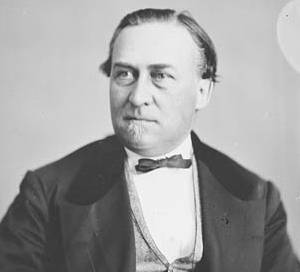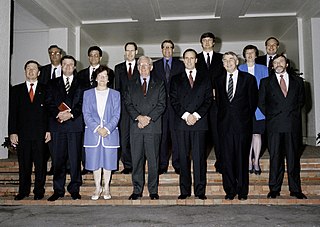Related Research Articles
Minister of State is a title borne by politicians or officials in certain countries governed under a parliamentary system. In some countries a ’Minister of State’ is a junior minister, who is assigned to assist a specific cabinet minister. In other countries a ’Minister of State’ is a holder of a more senior position, such as a cabinet minister or even a head of government.
The Cabinet of Canada is a body of ministers of the Crown that, along with the Canadian monarch, and within the tenets of the Westminster system, forms the government of Canada. Chaired by the prime minister, the Cabinet is a committee of the Queen's Privy Council for Canada and the senior echelon of the Ministry, the membership of the Cabinet and ministry often being co-terminal; as of November 2015 there are no members of the latter who are not also members of the former.
A minister without portfolio is either a government minister with no specific responsibilities or a minister who does not head a particular ministry. The sinecure is particularly common in countries ruled by coalition governments and a cabinet with decision-making authority wherein a minister without portfolio, while he or she may not head any particular office or ministry, still receives a ministerial salary and has the right to cast a vote in cabinet decisions. In some countries where the executive branch is not composed of a coalition of parties and, more often, in countries with purely presidential systems of government, such as the United States, the position of minister without portfolio is uncommon.
A parliamentary secretary is a member of the Parliament in the Westminster system who assists a more senior minister with their duties. In several countries the position has been re-designated as assistant minister.

The Cabinet of Australia is the Australian Government's council of senior ministers of the Crown, responsible to Parliament. Ministers are appointed by the Governor-General, on the advice of the Prime Minister, who serve at the former's pleasure. Cabinet meetings are strictly private and occur once a week where vital issues are discussed and policy formulated. The Cabinet is also composed of a number of Cabinet committees focused on governance and specific policy issues. Outside the Cabinet there is an Outer Ministry and also a number of Assistant Ministers, responsible for a specific policy area and reporting directly to a senior Cabinet minister of their portfolio. The Cabinet, the Outer Ministry, and the Assistant Ministers collectively form the full Commonwealth Ministry of the government of the day.

The cabinet of the Netherlands is the main executive body of the Netherlands. The current cabinet of the Netherlands is the Third Rutte cabinet, which has been in power since 26 October 2017. It is headed by Prime Minister Mark Rutte and his deputies Hugo de Jonge, Kajsa Ollongren and Carola Schouten.

The Secretary of State for Canada, established in 1867 with a corresponding department, was a Canadian Cabinet position that served as the official channel of communication between the Dominion of Canada and the Imperial government in London.

The Executive Council of Ontario, informally, and more commonly, the Cabinet of Ontario, plays an important role in the Government of Ontario, in accordance with the Westminster system.
A Minister of State is a junior cabinet minister in the Cabinet of Canada, usually given specific responsibilities to assist a senior cabinet minister in a specific area. A Secretary of State also holds many similar responsibilities in assisting senior cabinet members, being members of the Ministry and the Queen's Privy Council for Canada. A Secretary of State is legally a Minister of State styled as secretaries. However Secretaries of State are considered junior to ministers of state and are not members of Cabinet.
The First Keating Ministry (Labor) was the 59th ministry of the Government of Australia, and was led by Prime Minister Paul Keating. It succeeded the Fourth Hawke Ministry upon its swearing in by Governor-General Bill Hayden on 20 December 1991. It was replaced by the Second Keating Ministry on 24 March 1993 after the 1993 election.

The Second Keating Ministry (Labor) was the 60th ministry of the Government of Australia, and was led by Prime Minister Paul Keating. It succeeded the First Keating Ministry upon its swearing in by Governor-General Bill Hayden on 24 March 1993 after the 1993 election, and was replaced by the First Howard Ministry led by John Howard on 11 March 1996 following the Labor government's defeat at the 1996 election.
The First Howard Ministry was the 61st ministry of the Government of Australia, and was led by Prime Minister John Howard. It succeeded the Second Keating Ministry upon its swearing in by Governor-General Sir William Deane on 11 March 1996 after the 1996 election, and was replaced by the Second Howard Ministry on 21 October 1998 following the 1998 election.
Monique Landry, is a Canadian former politician.

The Cabinet of Malaysia is the executive branch of the Government of Malaysia. Led by the Prime Minister, the cabinet is a council of ministers who are accountable collectively to the Parliament. According to the Article 43 of the Constitution, members of the Cabinet can only be selected from members of either houses of Parliament. Formally, the Yang di-Pertuan Agong appoints all Ministers on the advice of the Prime Minister. The constitution is amended by repealing the Clause (8) of Article 43, enabling a person who is a member of State Legislative Assembly to continue to be one even when he or she is appointed as a minister or deputy minister in the cabinet. Ministers other than the Prime Minister shall hold office during the pleasure of the Yang di-Pertuan Agong, unless the appointment of any Minister shall have been revoked by the Yang di-Pertuan Agong on the advice of the Prime Minister but any Minister may resign his office. In practice, the Yang di-Pertuan Agong is obliged to follow the advice of the Prime Minister on the appointment and dismissal of ministers.

The Twenty-Sixth Canadian Ministry was the combined cabinet, chaired by Prime Minister Jean Chrétien, and the contemporary secretaries of state. It governed Canada from 4 November 1993 to 12 December 2003, including the 35th Canadian Parliament, the 36th, and the first half of the 37th. The government was formed by the Liberal Party of Canada. One particular fact of this ministry is the creation of Secretaries of State out of the Cabinet, but still in the ministry.
The Carpenter Ministry was the 34th Ministry of the Government of Western Australia, and was led by Labor Premier Alan Carpenter and his deputy Eric Ripper. It succeeded the Gallop Ministry on 3 February 2006 due to the retirement of Dr Geoff Gallop from politics on 25 January, and was in turn succeeded by the Barnett Ministry on 23 September 2008 after the Labor Party lost government at the state election held on 6 September.
The Barnett Ministry was the 35th Ministry of the Government of Western Australia. It included 13 members of the Liberal Party, three members of the National Party and an independent. It was led by the Premier of Western Australia, Colin Barnett, and Deputy Premier Liza Harvey. It succeeded the Carpenter Ministry on 23 September 2008 following the 2008 election and was succeeded by the McGowan Ministry following the Liberal Party's defeat at the 2017 election.
The Gallop Ministry was the 33rd Ministry of the Government of Western Australia, and was led by Labor Premier Geoff Gallop and his deputy, Eric Ripper. It succeeded the Court–Cowan Ministry on 16 February 2001, following the defeat of the Liberal-National coalition government at the 2001 election six days earlier. The Ministry was reconstituted on 10 March 2005 following the February 2005 election. It was succeeded by the Carpenter Ministry on 3 February 2006 due to the retirement of Dr Geoff Gallop from politics on 25 January.
The title secretary of state or state secretary is commonly used for senior or mid-level posts in governments around the world. The role varies between countries, and in some cases there are multiple secretaries of state in the government.

The Ministry of the Presidency, Relations with the Cortes and Democratic Memory (MPR) is the department of the Government of Spain which assures the link between the different Ministries and the Prime Minister and is responsible for the relations between the Government and the Parliament.
References
- ↑ Forsey, Eugene. [1980] 2016. "Parliamentary Government." Ch. 1 in How Canadians Govern Themselves (9th ed.). Ottawa, ON: Library of Parliament.
| This Canadian government–related article is a stub. You can help Wikipedia by expanding it. |